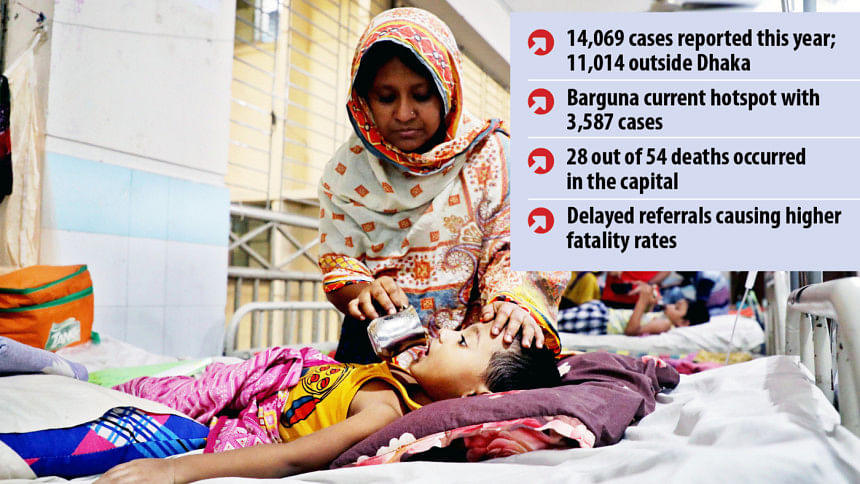Dhaka sees fewer dengue cases, but more deaths

Though most dengue cases are being reported from outside Dhaka, the majority of deaths are occurring within the capital.
According to the Directorate General of Health Services (DGHS), a total of 14,069 patients were hospitalised as of yesterday morning, with 11,014 of them from outside Dhaka.
The Barishal division alone has recorded 5,957 cases, while Barguna district -- currently the country's hotspot -- has reported 3,587 cases.
However, DGHS data shows that out of the 54 reported deaths, 28 occurred in Dhaka city, with 22 in areas under the Dhaka South City Corporation.
HM Nazmul Ahsan, associate professor at Shaheed Suhrawardy Medical College Hospital, said many critically ill patients are referred from local hospitals outside Dhaka to major hospitals in the city.
"When these patients arrive, their condition is often already critical," he said. "They get infected outside the capital but die in Dhaka hospitals, which may explain the higher number of deaths reported in the city."
He pointed to the time delay as a major factor. "When a patient travels from Barishal or other distant districts, it can take five to six hours to reach a Dhaka hospital and another hour for admission. If a patient is already in shock, this delay can push them into a more critical stage."
Ahsan urged local hospitals to follow national dengue treatment guidelines and provide care at the district level. "Only patients in very serious condition should be transferred to Dhaka. Often, patients are referred prematurely out of fear, even when they are not critical."
He said patients in shock should only be referred after initial stabilisation. "But many hospitals do not follow this, leading to patients reaching Dhaka in decompensated shock, where the risk of death is very high."
Public health expert Mushtaq Hussain said while the healthcare system outside Dhaka is well-structured -- with community clinics, union health centres, upazila health complexes, and district hospitals -- Dhaka lacks this multi-tiered setup.
"In Dhaka, all medical manpower is concentrated in medical college hospitals," he said. "There are no proper primary healthcare centres in the city, and the few secondary hospitals often remain underutilised due to a lack of facilities like major operation theatres."
Mushtaq said poor people in Dhaka often seek care only in the later stages of illness because of these limitations. "If dengue testing were available in local community clinics, people would get tested earlier. But under the current system, they must travel far to a government hospital to get tested at subsidised rates, which causes delays."
He noted that complications from dengue usually develop after the fever subsides, but many people ignore early symptoms.
Acknowledging the lack of precise data, Mushtaq stressed the need to revise the treatment approach. He recommended dividing care into three levels -- primary, secondary, and tertiary -- to improve patient management and reduce mortality.
"A stronger primary healthcare system is essential, especially for low-income communities that lack access to early testing," he said.
He also proposed setting up more blood collection centres and expanding secondary care services in Dhaka to ease the burden on medical college hospitals.
"City corporation and railway hospitals could be used as secondary care facilities, while only the critical patients should be referred to medical colleges," he added.

 For all latest news, follow The Daily Star's Google News channel.
For all latest news, follow The Daily Star's Google News channel. 



Comments